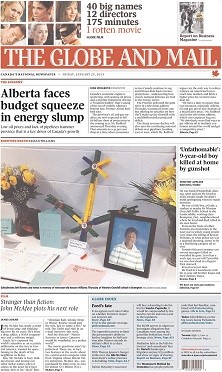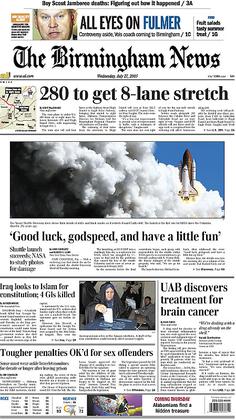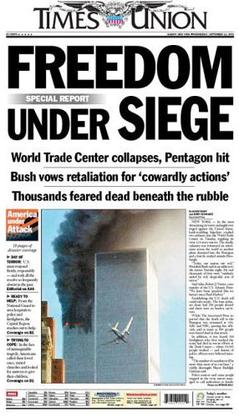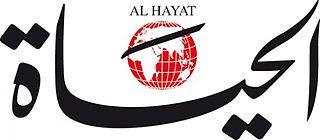
The Economist is a British weekly newspaper printed in demitab format and published digitally. It focuses on current affairs, international business, politics, technology, and culture. Based in London, the newspaper is owned by the Economist Group, with its core editorial offices in the United States, as well as across major cities in continental Europe, Asia, and the Middle East. In 2019, its average global print circulation was over 909,476; this, combined with its digital presence, runs to over 1.6 million. Across its social media platforms, it reaches an audience of 35 million, as of 2016. The newspaper has a prominent focus on data journalism and interpretive analysis over original reporting, to both criticism and acclaim.
The Wall Street Journal is an American business and economic-focused international daily newspaper based in New York City. The Journal is published six days a week by Dow Jones & Company, a division of News Corp. The newspaper is published in broadsheet format and online. The Journal has been printed continuously since its inception on July 8, 1889. The Journal is regarded as a newspaper of record, particularly in terms of business and financial news. The newspaper has won 39 Pulitzer Prizes, the most recent in 2023.

The Globe and Mail is a Canadian newspaper printed in five cities in western and central Canada. With a weekly readership of approximately 2 million in 2015, it is Canada's most widely read newspaper on weekdays and Saturdays, although it falls slightly behind the Toronto Star in overall weekly circulation because the Star publishes a Sunday edition, whereas the Globe does not. The Globe and Mail is regarded by some as Canada's "newspaper of record".
The Daily Illini, commonly known as the DI, is a student-run newspaper that has been published for the community of the University of Illinois Urbana-Champaign since 1871. Weekday circulation during fall and spring semesters is 7,000; copies are distributed free at more than 100 locations throughout Champaign–Urbana.
The South End is the official student newspaper of Wayne State University in Detroit, Michigan, published in print and online. It was founded in 1967, and its publication is funded partly from university funds and partly from advertising revenues. It is distributed free of charge.

The Technique, also known as the "'Nique", is the official student newspaper of the Georgia Institute of Technology in Atlanta, Georgia, and has referred to itself as "the South's liveliest college newspaper" since 1945. As of the fall semester of 2011, the Technique has a weekly circulation of 10,000, distributed to numerous locations on the Georgia Tech campus and a handful of locations in the surrounding area. The first issue of the Technique was published on November 17, 1911, and the paper has printed continuously since its founding. The paper publishes weekly throughout the regular school year and primarily covers news, events and issues specific to the Georgia Tech community. In 2004 it was one of 25 collegiate newspapers to receive the Pacemaker award from the Associated Collegiate Press.
A weekly newspaper is a general-news or current affairs publication that is issued once or twice a week in a wide variety broadsheet, magazine, and digital formats. Similarly, a biweekly newspaper is published once every two weeks. Weekly newspapers tend to have smaller circulations than daily newspapers, and often cover smaller territories, such as one or more smaller towns, a rural county, or a few neighborhoods in a large city. Frequently, weeklies cover local news and engage in community journalism.
The Badger Herald is a newspaper serving the University of Wisconsin–Madison community, founded in 1969. The paper is published Monday through Friday during the academic year and once during the summer. Available at newsstands across campus and downtown Madison, Wisconsin and published on the web, it has a print circulation of 6,000.

The Birmingham News was the principal newspaper for Birmingham, Alabama, United States in the latter half of the 20th Century and the first quarter of the 21st. The paper was owned by Advance Publications and was a daily newspaper from its founding through September 30, 2012. After that day, the News and its two sister Alabama newspapers, the Press-Register in Mobile and The Huntsville Times, moved to a thrice-weekly print-edition publication schedule.

The Times Union, or Times-Union, is an American daily newspaper, serving the Capital Region of New York. Although the newspaper focuses on Albany and its suburbs, it covers all parts of the four-county area, including the cities of Troy, Schenectady and Saratoga Springs. In 2021, the paper also expanded to covering the Hudson Valley. It is owned by Hearst Communications. The paper was founded in 1856 as the Morning Times, becoming Times-Union by 1891, and was purchased by William Randolph Hearst in 1924. The sister paper Knickerbocker News merged with the Times Union in 1988. The newspaper has been online since 1996.

Printed media in the Soviet Union, i.e., newspapers, magazines and journals, were under strict control of the Communist Party and the Soviet state. The desire to disseminate propaganda was believed to had been the driving force behind the creation of the early Soviet newspapers. Newspapers were the essential means of communicating with the public, which meant that they were the most powerful way available to spread propaganda and capture the hearts of the population. Additionally, within the Soviet Union the press evolved into the messenger for the orders from the Central Committee to the party officials and activists. Due to this important role, the Soviet papers were both prestigious in the society and an effective means to control the masses. However, manipulation initially was not the only purpose of the Soviet Press.

The history of American newspapers begins in the early 18th century with the publication of the first colonial newspapers. American newspapers began as modest affairs—a sideline for printers. They became a political force in the campaign for American independence. Following independence the first amendment to U.S. Constitution guaranteed freedom of the press. The U.S. Postal Service Act of 1792 provided substantial subsidies: Newspapers were delivered up to 100 miles for a penny and beyond for 1.5 cents, when first class postage ranged from six cents to a quarter.

Al-Hayat was a London-based, pan-Arab newspaper owned by Saudi Prince Khalid bin Sultan, that had a circulation estimated over 200,000. It was the newspaper of record for the Arab diaspora and the preferred venue for liberal intellectuals who wish to express themselves to a large public. Founded in 1946, the paper closed in March 2020 after years of financial problems.
The Daily Campus, founded in 1896, is a student-run newspaper at the University of Connecticut that has a circulation of 2,000 on weekdays during school term. The Daily Campus has the largest circulation of any college paper in Connecticut and the third-largest in New England, behind The Daily Collegian (UMass) and The Harvard Crimson. Since its creation, the newspaper has undergone several name changes, having starting as The Storrs Agricultural College Lookout, a monthly, when it published its first issue on May 11, 1896. The name was changed to The Connecticut Campus in 1915, followed by The Connecticut Daily Campus, and then finally The Daily Campus in 1984. It began publishing five days a week during the academic year in 1952 and became a morning paper in 1955.
The Tracy Press is a weekly newspaper published in Tracy, California, United States. Established in 1898 by William Paul Friedrich the Tracy Press was operated by the Matthews family from 1943 to 2012. The Tracy Press is now co-published by Will Fleet and Ralph Alldredge, who purchased the newspaper and took over publication Nov. 12, 2012, under the name Tank Town Media. It remains one of the few family-owned newspapers still in existence in California. As of 2014, the paper has an average weekly circulation of over 10,000 and covers both *Tracy, California and Mountain House.

The Montreal Gazette, formerly titled The Gazette, is the only English-language daily newspaper published in Montreal, Quebec, Canada. Three other daily English-language newspapers shuttered at various times during the second half of the 20th century. It is one of the French-speaking province's last two English-language dailies; the other is the Sherbrooke Record, which serves the anglophone community in Sherbrooke and the Eastern Townships southeast of Montreal.
Capitalist Piglet was a comic strip that appeared briefly in The Sheaf during 2005–2006, and is best known for a controversial installment depicting Jesus Christ performing fellatio on a cartoon pig.

A newspaper is a periodical publication containing written information about current events and is often typed in black ink with a white or gray background.
The Rider News is the weekly independent student newspaper of Rider University in Lawrenceville, New Jersey. The Rider News routinely wins top awards from the New Jersey Press Association and from the regional division of the Society of Professional Journalists, successfully competing against institutions from Maine to Eastern Pennsylvania.

There were five important periods in the history of Canadian newspapers' responsible for the eventual development of the modern newspaper. These are the "Transplant Period" from 1750 to 1800, when printing and newspapers initially came to Canada as publications of government news and proclamations; followed by the "Partisan Period from 1800–1850," when individual printers and editors played a growing role in politics. The "Nation Building Period from 1850–1900," when Canadian editors began the work of establishing a common nationalistic view of Canadian society. The "Modern period" from 1900 to 1980s saw the professionalization of the industry and the growth of chains. "Current history" since the 1990s saw outside interests take over the chains, as they faced new competition from the Internet.










